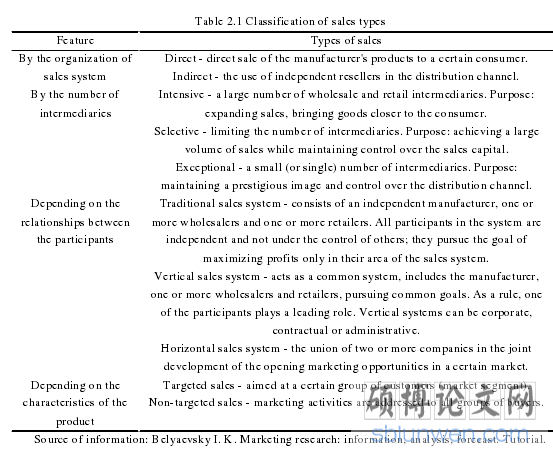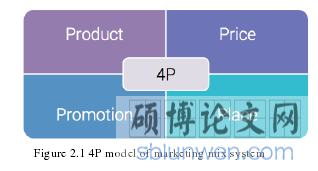1.1 Research background, purpose and significance
The problem of sales management is currently particularly relevant, since in the conditions of market relations, when there is increased competition in various areas of production and sales, it is important not only to produce high-quality goods in a certain amount, but also to organize effective sales channels for products. Otherwise, even high-quality products may be unrealized, which will cause losses due to their long storage, loss of consumer qualities and other reasons.
In the market relations conditions, the commercial success of an enterprise depends not only on production capabilities, but more on the successful sale of products, which is provided by effective sales management with the use of modern marketing tools that allow to sell products and stimulate sales [1].
Sales is a system of relations in the sphere of commodity-money exchange between economically and legally free subjects of the sales market, realizing their commercial needs. The subjects of the sales market are sellers and buyers, and the object of sale is directly the product in the marketing sense of the word.
Under the marketing/sales activities should be understood the process of promoting finished products to the market and the organization of commodity exchange in order to extract entrepreneurial profit. Here, finished products are understood as a completed products, works and services at a given enterprise that can be offered to the market as goods.
The sale of manufactured products is an integral part of the activities of enterprises in a market economy. A company can count on real commercial success only if rationally organized distribution and exchange, i.e. sales of products.
.............................
1.2 The background and level of domestic and foreign research
Until 1990, in Belarus in practice there were two types of movement of goods: one through state trade for consumer goods, and the other through the organization of national and departmental logistics systems. These types represented a rigid stock distribution and delivery of products according to planned acts.
The transition to the market has broken the system of centralized material and technical supply of enterprises. Logistics organizations and enterprises have turned into sales and commercial agents providing services to enterprises on self-supporting and mutually beneficial conditions. All of them have a ready-made network of warehouses, bases, shops, production sites.
In combination with the variety of functions performed by them, this this in the result reduces production and inventory at the enterprises they serve, contributing to savings in distribution costs, accelerating the turnover of funds and maintaining the rhythm of production. In other words, organizations and enterprises of material and technical support contribute to the achievement of rationality of economic relations for the supply of products for various purposes.
The experience of countries with a developed system of market relations shows that there are various types of specialized supply and marketing organizations. They differ between themselves in the range of services provided to customers, product specialization, servicing of certain categories of customers, etc.
Therefore, sales management, as a special area of the enterprise, is currently undergoing significant changes. The market itself, as well as the conditions presented by the market, forced the heads of enterprises to pay special attention to issues of sale of products, and, therefore, ensuring its competitiveness. Since the effectiveness of the sales system to a decisive extent depends on its management, so in the practical work of entrepreneurs and managers is given the leading position to sales management.
..........................
2 Related theory
2.1 Theory of marketing
2.1.1 The concepts of sales and essence of organization of sales
The organization of sales in the enterprise system and its management plays a very important role in the sense that, on the one hand, it provides the company's income and, on the other hand, provides feedback production with the market, and is also a source of information about the demand and needs of consumers.
The concept of sales activities was first formulated by Harvard Business School in 1958 and was as follows: “Sales activities exist in order to together with a profit satisfy consumer requirements.” The essence of this logic can be represented as the purchase and sale of goods aimed at market (consumer) demand and receiving a well-deserved profit [9].
The statements of the founder of the French administrative school, A. Fayol, are very instructive: “Mastery of selling is characterized by a deep knowledge of the market and the strength of rivals, distant foresight and practice of agreements. The sales function ensures that the prices set to higher organizations are not a source of dangerous misconceptions.”
According To M. Akulich, sales activity is the practice of exchanging material values and services, i.e. a special type of activity on which the final results of the company's economic activity as a whole depend. Sales activity is aimed at the realization of definite types of products, no matter when it is carried out: before the start of production (on the basis of the order) or after the completion of production (search for buyers of already produced goods, when the manufacturer works for an unknown market) [10].

............................
2.2 Theory of sales management and its stimulation
2.2.1 4P marketing mix model
Marketing mix model or also called marketing complex is a basic element of any business strategy. The model is simple and universal in use, and is a kind of checklist for the effective development of the company's product on the market. Because of its simplicity the marketing mix model can be used by anyone - even a person who is not a specialist in marketing .
The term Marketing Mix (or “marketing complex”) was invented and first used by Neil Borden in 1964 in his article The Concept of the Marketing Mix. Using this concept, Borden wanted to systematize and describe all the marketing tools, necessary to create a marketing plan for the development of a company's product. To create such a convenient tool for the development a marketing strategy, Borden was pushed by his partner James Culliton, who in 1948 in an unusual way described the company's marketer, comparing him with “a mixer of the necessary ingredients” [20].
The initial marketing mix according to Borden consisted of a huge number of “ingredients” and included 4 market forces and 12 elements. This is perhaps the most complete scheme of the tools used by marketers.
Borden identified the following 4 market forces: purchasing behavior of consumers; behavior of trade distributors; position and behavior of competitors; behavior of government. A list of a set of marketing elements is as follows: goods; price formation; trademark; distribution channels (distribution); activities of sales representatives (personal sales); advertising; promotion; packaging; product demonstration; service (servicing); material treatment (storage and transportation); search for factors and data analysis.

.................................
3 Existing situation and problems of sales at UPE “YAVID” ................................................ 33
3.1 UPE “YAVID” introduction ................................ 33
3.1.1 Background of the enterprise .................................. 33
3.1.1.1. Characteristics of the enterprise, its organizational and production management structure ....................... 33
3.1.1.2. The main directions of production activity of the enterprise ...................... 36
4 Measures of stimulation sales at UPE “YAVID” and calculation of their costs and effectiveness ....................... 63
4.1 Measures of stimulation sales at UPE “YAVID” ............................. 63
4.1.1 Implementing the CRM system at the enterprise .............................. 63
4.1.2 Conduct training “Technology and psychology of sales” .............................. 67
4 Measures of stimulation sales at UPE “YAVID” and calculation of their costs and effectiveness
4.1 Measures of stimulation sales at UPE “YAVID”
4.1.1 Implementing the CRM system at the enterprise
In today's world, the need for automation of various processes has become an important component of successful business, for example:
(1) Automation of the sales process, which helps to manage the life cycle of each trade operation to its successful completion. It also allows you to adjust the distribution channel, gives an accurate forecast of sales; automating routine work, allows you to do without the help of administrative and managerial personnel, and also provides sales managers with the necessary information about existing and potential customers. Means of automating the sales process include: contact management, preparation of commercial offers, sales management and tracking of order execution. In combination with tools for researching the customer base, automation allows you to create a comprehensive view of each consumer. It also provides each sales manager with automated account management.
(2) Marketing automation and optimization tools that help determine the customer’s profile based on many characteristics - his preferences, customer behavior, frequency of purchases, recent purchases, demographics. These tools are not based on marketing theory, but on real consumer behavior. Researches show that a reliable indicator of what to expect from the client in the future is his past behavior and specificity. When the information is collected and structured in a customer database, marketing automation tools are involved: a product promotion campaign, questionnaires, and analysis of the received responses. Using advanced marketing automation tools, it is possible to predict the possible responses of customers. Marketing automation tools are a step forward: they increase the company's profits, coordinate probable customer demand with the organization’s capabilities in providing the customer with the necessary goods. These funds are also fundamental to the implementation of programs that promote consumer loyalty, for example, programs that encourage passengers to use air transport.
...................................
Conclusion
The work reveals the meaning and essence of sales, studied the marketing and sales stimulation models. The development of 4P, 4C and 4R marketing mix models reflects the changing external competitive environment and the evolution of the marketing concepts. Initially, the marketing orientation was focused on the enterprise (4P model), the purpose of which is to satisfy the same or similar needs and maximize profits. Then, with the development of the market, the emphasis of marketing began to shift to the customer (4C model), where the main activity of the enterprise was to satisfy the individual needs of consumers and get their loyalty. In the modern highly competitive consumer market, there is an interaction between the enterprise and the customer (4R model) and the need to quickly respond to changes in market conditions, create new conditions for consumption and strive for mutual benefit.
Therefore, today just effective sales organization is no longer enough, and in modern conditions, its stimulation occupies an important place in the system of promotion of goods and services in general, as well as has a number of advantages for enterprises. A high level of competition forces enterprises to stimulate the sale of their products, using various means of stimulating influence, designed to accelerate and/or strengthen the market response (lower prices, coupons, gifts, contests, lotteries, cash prizes). Compared to advertising, the main goal of stimulation is to influence the consumer and simplify the sales process, which allows to stimulation quickly impact on demand, helps attract new customers and maintain a commitment to the product or store.
reference(omitted)
